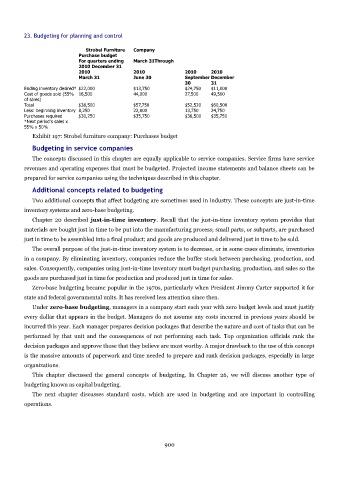Page 899 - Accounting Principles (A Business Perspective)
P. 899
23. Budgeting for planning and control
Strobel Furniture Company
Purchase budget
For quarters ending March 31Through
2010 December 31
2010 2010 2010 2010
March 31 June 30 September December
30 31
Ending inventory desired* $22,000 $13,750 $24,750 $11,000
Cost of goods sold (55% 16,500 44,000 27,500 49,500
of sales)
Total $38,500 $57,750 $52,520 $60,500
Less: beginning inventory 8,250 22,000 13,750 24,750
Purchases required $30,250 $35,750 $38,500 $35,750
*Next period's sales x
55% x 50%
Exhibit 197: Strobel furniture company: Purchases budget
Budgeting in service companies
The concepts discussed in this chapter are equally applicable to service companies. Service firms have service
revenues and operating expenses that must be budgeted. Projected income statements and balance sheets can be
prepared for service companies using the techniques described in this chapter.
Additional concepts related to budgeting
Two additional concepts that affect budgeting are sometimes used in industry. These concepts are just-in-time
inventory systems and zero-base budgeting.
Chapter 20 described just-in-time inventory. Recall that the just-in-time inventory system provides that
materials are bought just in time to be put into the manufacturing process; small parts, or subparts, are purchased
just in time to be assembled into a final product; and goods are produced and delivered just in time to be sold.
The overall purpose of the just-in-time inventory system is to decrease, or in some cases eliminate, inventories
in a company. By eliminating inventory, companies reduce the buffer stock between purchasing, production, and
sales. Consequently, companies using just-in-time inventory must budget purchasing, production, and sales so the
goods are purchased just in time for production and produced just in time for sales.
Zero-base budgeting became popular in the 1970s, particularly when President Jimmy Carter supported it for
state and federal governmental units. It has received less attention since then.
Under zero-base budgeting, managers in a company start each year with zero budget levels and must justify
every dollar that appears in the budget. Managers do not assume any costs incurred in previous years should be
incurred this year. Each manager prepares decision packages that describe the nature and cost of tasks that can be
performed by that unit and the consequences of not performing each task. Top organization officials rank the
decision packages and approve those that they believe are most worthy. A major drawback to the use of this concept
is the massive amounts of paperwork and time needed to prepare and rank decision packages, especially in large
organizations.
This chapter discussed the general concepts of budgeting. In Chapter 26, we will discuss another type of
budgeting known as capital budgeting.
The next chapter discusses standard costs, which are used in budgeting and are important in controlling
operations.
900

